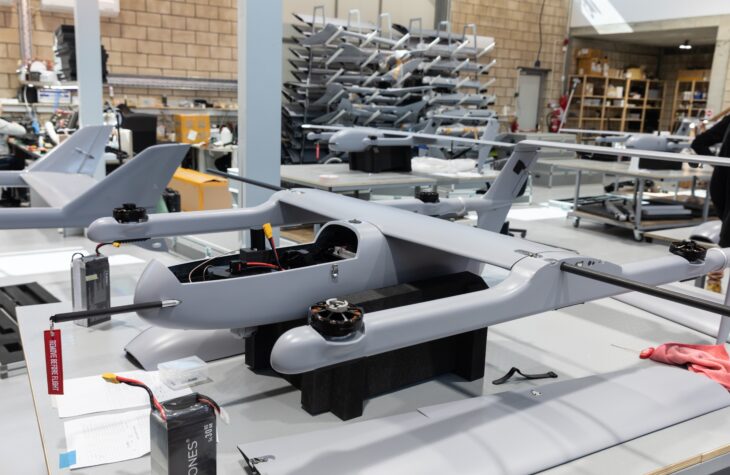
Primer: An America First Drone Strategy

Drone warfare is rapidly changing the theories of offense–defense balance and is leading to what is called an “offense-dominated” world. Recent conflicts support that conclusion. Rapid development of a drone dominance program is needed to maintain American preponderance in the global balance of power as the United States faces an emergent multipolarity.
According to a new White House fact sheet, the U.S. government is focusing on becoming a drone-dominant power. “Drones enhance U.S. productivity, create high-skilled jobs, and are reshaping the future of aviation in areas such as logistics, infrastructure inspection, precision agriculture, emergency response, and public safety,” the fact sheet says. “Emerging technologies, such as vertical takeoff and landing aircraft, promise to modernize methods for cargo delivery, passenger transport, and other advanced air mobility capabilities.” It adds that “for too long, unfair foreign competition has posed a national security risk, disincentivizing our drone industrial base. This order is removing regulatory barriers and directing federal agencies to prioritize U.S.-manufactured drones, secure our supply chains, and promote American leadership in production, certification, and export.”
This is a welcome development. Drone warfare is rapidly changing the theories of offense–defense balance and is leading to what is called an “offense-dominated” world. Recent conflicts support that conclusion. Rapid development of a drone dominance program is needed to maintain American preponderance in the global balance of power as the United States faces an emergent multipolarity. This brief is one of the Center for Renewing America’s many forthcoming strategy papers on the contours of an America First drone program. This brief explains what an offense-dominated world might look like. It then highlights a few select examples from recent conflicts. Finally, it provides some guidelines for a drone-dominant offensive strategy.
An “Offense-Dominated” Multipolarity
Several variables, including terrain, geographic proximity, and technology, determine whether we live in an offense-dominated world or a defense-dominated one. Whether offense or defense has an advantage in turn changes a given state’s calculus about the relative costs and benefits for offense or defense, and ultimately affects statecraft.
Robert Jervis gave a simple definition of each position nearly fifty years ago: “When we say that the offense has the advantage, we simply mean that it is easier to destroy the other’s army and take its territory than it is to defend one’s own. When the defense has the advantage, it is easier to protect and to hold than it is to move forward, destroy, and take.” Put simply, the question is whether offense or defense has the advantage. This affects the state’s calculus on initiating a conflict: who starts a war and who deters it based on what the parties consider advantageous.
Of all the variables mentioned, geography determines the decision about initiating a conflict. Flat terrains, plains, and deserts favor offense, both mass offense and hit and runs. Forest, swamps, mountains, sea, and distance favor defense. Mud, snow, and other natural barriers favor defense. Sheer mass can occasionally overwhelm good defense. But mass can also suffer from major casualty rates if there is good defense, especially if that defense is coupled with good technology, geographical barriers, or a helpful climate. The key causal factor in measuring offense–defense balance, though, is technology. Technology can favor both offense and defense.
The history of warfare can be read as a competition between offensive and defensive technologies—armored knights, spears, arrows, chariots, cannons, tanks, Gatling guns, battleships, trench-digging equipment, fighter jets, and drones—leading to offense- and defense-dominated worlds. It is difficult to categorize modern war history, but one can cautiously argue that since the dawn of the Industrial Revolution and modernity, the security scenario has been mostly defense-dominated. The British defeated thousands of Zulus despite their smaller numbers thanks to their Martini–Henry guns. The Gatling gun was used to devastating effect in the first industrial conflict of the world, the American Civil War.
There have been periodic, brief changes in the balance. The introduction of tanks in the First World War altered trench warfare before both sides restored the balance. The Germans in World War II used terrain, technology, and tactics to successfully initiate and operationalize Blitzkrieg. But eventually defense won out, and cheaper defensive weapons, greater combatant numbers, and mass manufacturing doomed the German war machine, which relied on expensive and massive platforms. Likewise, cheap offense overwhelmed its expensive platforms. Nowhere was this more evident than in mammoth battleships’ becoming obsolete because of small dive bombers.
Shift in Balance: Cheap Mass Overwhelming Expensive Class
The last five years provide examples of a new battlespace.
Consider the near-peer rivalry of India and Pakistan. In the world’s first drone war between nuclear-armed neighbors, Pakistan fired three hundred to four hundred Turkish-made drones on the first night of its conflict with India this May. Around fifty of the drones were shot down by air defense guns, and another twenty were neutralized by jamming radio frequencies. Per Indian defense sources, the rest went through. In return, an Indian drone destroyed a Pakistani AD radar. The drones also provided restraint and deniability, thus reducing the risk of open escalation. “The Indo-Pak conflict is moving into a new drone era—one where ‘invisible eyes’ and unmanned precision may determine escalation or restraint. . . . The side that masters drone warfare won’t just see the battlefield—they’ll shape it,” Jahara Matisek, a professor at the U.S. Naval War College, told the BBC. Drones were also used for both “tracking and triggering” operations, providing flexibility for a cheap asset to be used for both offensive and defensive platforms.
In Israel, Hamas in 2023 enjoyed operational surprise by using $6,000 drones to overwhelm Israeli defenses; each Iron Dome interceptor missile cost five times more, and each unit of David’s Sling cost around one million dollars, not including the cost of personnel or maintenance. Hamas is a militia, so it does not possess operational or logistical depth, but one can imagine a peer-to-peer scenario in which offense overwhelms defense.
In fact, in a peer war between Armenia and Azerbaijan in 2020, the latter destroyed the former. Armenia depended on the older Soviet strategy of using mass and armor, and Azerbaijan prevailed using cheaper, mass-produced Israeli and Turkish drones. A similar dynamic was observed in Sudan last year, when Turkish drones helped the Sudanese army advance and hold territory.
The largest natural experiment of drone warfare has been in the Ukrainian theater. Ukraine defended Kiev against Russia’s air assault due to cheap technology, with $400 drones obliterating Russian tanks. Ukraine’s unmanned Sea Baby drones sank Russian ships. A recent report noted that “their biggest success, though, has been at sea, where a $250,000 craft loaded with 500 kilograms of explosives has shown it can sink a $300-million warship bristling with weapons. Kyiv’s maritime drones managed to defeat Russia’s Black Sea Fleet, pride of Moscow’s navy, forcing it to retreat from its Crimea base. They hit 17 air and sea targets, totally destroying 15 of them—striking five ships, six patrol vessels, two landing craft, two helicopters and, earlier this month, shooting down two SU-30 fighter jets using Sidewinder missiles.”
The Russians did the same, destroying German-donated Leopard tanks with handheld fiber-optic cable drones. In other instances, some nonweaponized drones geolocated and target-coordinated German tanks for Russian platoons with shoulder-fired missiles to follow through. The report added, “The Kremlin has even introduced ‘drone studies’ into classrooms to help produce the next generation of developers. It has taken a lead also in using fibre-optics—with filaments up to 40 kilometres long—to avoid jamming, showing how advances can be creative adaptation of existing technologies rather than innovative breakthroughs.”
An Imperial World Order and an America First Drone Strategy
What does all this mean for the American grand strategy? A few defining principles can be extrapolated.
First, cheap offense will more often than not overwhelm expensive defense. Logically, therefore, countries that can manufacture cheap offensive platforms are going to be the new powers in a multipolarity. Rich countries have a natural advantage, but so do poor countries with significant manpower or an intact manufacturing base and production capacity. If a rich country does not have production capacity or has manpower either that is too rich or otherwise will not work in manufacturing, it should aim to secure allies or protectorates who are poorer and so can act as the manufacturing hub. That means there will likely be attempts at nearshoring or securing of rare earth elements that enable chip production, along with consolidation of supply chains because of wholesale changes in economic systems.
Second, an arms race is forthcoming. Every prudent, technologically advanced major power in a technological competition spiral will ramp up arms production and focus on smaller, cheaper mass-produced platforms instead of massive legacy platforms. Turkey, Iran, and Russia are already moving in this direction. If any major power keeps spending on massive legacy platforms, those actions would indicate recklessness, nepotism, or lobbyism. In World War II, Germany perfected bigger platforms, but was outproduced by factories in Detroit and the Urals that made smaller and cheaper American and Soviet technologies. If cheap, mass-produced drones can overwhelm countries such as Russia and India, then one can imagine the offense scenario where richer great powers such as the United States, France, and Britain would start producing cheaper offensive platforms en masse. Tanks and F-35s will have to give way to thousands of automated platforms. Aircraft carriers, likewise, will be vulnerable to submarine drones and will go the way of battleships in a peer competition. The sinking of Russian capital ships near Ukraine is a sign of things to come.
Third, the world is becoming more offense-dominated. Instead of engaging in prolonged attritional warfare, most major states will favor initiating major overwhelming attacks, policing or ordering punitive raids, and employing “hit and run” tactics. War doctrines will reflect those strategies. Pre– World War I–style punitive raids that remain below the threshold of an all-out great power war will return. The new order will likely result in a global power balance that is more reminiscent of a pre–World War I multipolarity: a few great powers with massive offensive capabilities overwhelm smaller countries in an order similar to the heyday of European colonialism.
Smaller, poorer states are not, and will not be, capable of manufacturing massive, high-level technology or deterrent platforms, and their position relative to the balance will be low compared to that of richer powers with thousands of drones. That doesn’t mean Iraq War–style nation building will return as a strategic objective. It does, however, mean that great powers will wage increasingly shorter, ultraviolent punitive wars as they seek to secure supply chains, land, resources, manufacturing hubs, and protectorates. In short, we are returning to a world similar to the mid- to late nineteenth century: low-threshold conflicts and constant, short bouts of order-enforcing violence on smaller states under a negative but holding great power equilibrium. Smaller states will increasingly face a new form of imperialism. As Robert Gilpin wrote in his 1981 book War and Change in World Politics, “Military innovations that tend to favour the offense over the defense stimulate territorial expansion and the political consolidation of international systems by empires or great powers.”
A Drone Strategy Suited to Manage a Multipolarity
The Department of Defense (DOD) has belatedly noted the emergent order and correctly wants to supercharge U.S. drone innovation and production to confront China. “The directives of drone dominance support our industrial base, reform acquisition, and field new technology for the warfighter. Lethality will not be hindered by self-imposed restrictions, especially when it comes to harnessing technologies we invented but were slow to pursue,” Secretary of Defense Pete Hegseth recently said.
But challenges remain. As Jon Finer and David Shimer recently wrote in Foreign Affairs, “Having never experienced this form of combat, most countries in the world, including the United States, are now far behind the Ukrainians in this regard. Neither the U.S. military nor any European military can produce mass quantities of such low-cost and adaptable capabilities. Nor is it clear that the U.S. military is moving rapidly enough to incorporate battlefield lessons into its own doctrine.”
In the United States, weaponization, planning, and design are biased toward legacy platforms. The Pentagon spends an immense amount of money to design weapons that are big, bloated, and twenty years too late. The future drones currently being debated in the DOD that might saturate the market are too expensive to compete with Chinese manufacturing in terms of per-unit cost, with some products, intended for use in swarm attacks, ranging from $500,000 to $2 million per unit. Others are too primitive and dumb, designed for light shows and swarms but incapable of deterrence and vulnerable to anti-drone electronic warfare due to their design.
A recent essay in Foreign Affairs by Michael C. Horowitz, Lauren A. Kahn, and Joshua A. Schwartz says, “If Russia lost even one of each kind of the advanced aircraft Ukraine supposedly destroyed, it would have incurred serious costs: a single Russian airborne early warning and control system aircraft has an estimated price tag of $330 million, and Russia’s long-range bombers cost up to $270 million. By contrast, Ukraine’s quadcopters cost between $600 and $1,000 each, meaning that the total capabilities used in Spider’s Web likely cost Ukraine no more than $117,000, a fraction of the cost of a single Kh-101 missile carried by one of the destroyed Russian bombers, and less than the $200,000 per-unit Javelin antitank missiles the United States has provided to Ukraine.” The conclusion cannot be starker: “The Replicator Initiative’s initial $500 million expenditure amounted to just 0.05 percent of the U.S. defense budget in fiscal year 2024. The United States could comfortably spend ten times as much on precise mass capabilities—including on one-way attack drones and surveillance platforms—than it does by reprogramming money invested elsewhere in the Pentagon’s vast budget.”
A prudent policy, therefore, would be to invest more in multiple smaller companies and startups while keeping the market open for bigger legacy companies to innovate and adapt to changing demands. That approach would also discourage nepotism in government grants. The cheaper, primitive drones could be useful for short policing missions. The Defense Advanced Research Projects Agency’s Grand Challenge initiative or another DOD innovation unit could be pushed to foster competition. The DOD could fund grants to select universities targeted towards drone design and manufacturing.
Some changes are being made in that direction. The U.S. Army recently, through its Program Executive Office, sought out American companies that can mass manufacture drones that cost less than $2,000 each. And smaller American companies are already designing weaponized drones that could be deployed for various uses, from guarding the southern border to deterring school shooters. One can imagine using a similar approach for various foreign policy missions—including deterring piracy, drug cartels, and terrorism—that don’t require gigantic legacy platforms, whose prohibitive mission cost would not be compatible with the desired outcome, anyway. Government funds for drones should be tied to various criteria, including autonomy, competitiveness, and cost. These priorities would counteract the bias towards big defense monopolies and allow smaller companies to compete in the emerging market and promote innovation.
A second issue is anti-drone warfare. Given the nascent state of research in this field, the drone warfare market is not operationalized. The DOD has planned Hellscape, a doctrine that intends to flood the battlespace with swarm attacks in the event of a Chinese invasion of Taiwan. But there’s not much research or funding going in the opposite direction. In a real shooting contest with a near-peer adversary, it is expected that the adversary would attempt to destroy all swarm weaponry and all defensive measures with both standoff and counter–uncrewed aircraft system (UAS) capabilities. The United States severely lacks a near-peer ally to conduct exercises that test, simulate, and analyze any such data.
The third and perhaps the most important challenge facing the United States concerns manufacturing. The United States is an advanced, high-income country, so reshoring manufacturing is more difficult than is often claimed (though not impossible). The American higher education sector is designed to train people fit for white-collar and bureaucratic jobs and thus keeps the United States from being a low-labor-cost manufacturing superpower akin to China, Turkey, or other Asian countries. It currently lacks both high-tech expertise and a competent, trained work force to manufacture cheaper mass platforms on the required scale, similar to those of the 1940s. There is also a psychological angle. Americans who went to universities for the first generation naturally do not want to see their kids trained in manufacturing and trade for relatively lower-status entry-level jobs.
Reversing that trend would take generational training; it took the United States around twenty years to achieve parity with Great Britain in the naval domain and sixteen years to achieve parity with the Soviets in space. It would also require bipartisan policies that would design such a work force. The U.S. government should either push universities and private enterprises to train more workers or, in the short term, find allies or protectorates among high-manufacturing but low-income countries. In the short term, the U.S. government can also find already trained and experienced but cheaper labor from aligned countries such as Ukraine and Turkey and secure supply chains and drone components that do not rely on China.
Currently China (especially Da-Jiang Innovations) dominates the cheap commercial drone component industry, and it is difficult to manufacture drones in the United States without violating the National Defense Authorization Act (NDAA), which prohibits the DOD or any department or agency of the U.S. government from using drones built with components from certain countries deemed to be security threats or cybersecurity risks. In the longer term, the United States can also make DOD grants to American companies that prioritize training an American workforce.
Conclusion
The 1964 film Zulu’s depiction of the Anglo–Zulu War highlights the effects of technological disparity. “If it’s a miracle, Colour Sergeant, it’s a short chamber Boxer Henry point 45 caliber miracle,” Lieutenant John Chard (played by Sir Stanley Baker) reminds his subordinate after the battle of Rorke’s Drift. It has become almost axiomatic to say that the key to a long-lasting peace is not just a good shield but also a good sword hand.
International law theorists once mistook as normative the equilibrium provided by first bipolarity and then a very unsustainable and short-lived unipolarity. They are now worried that spheres of influence, rival blocs, territorial conquest, and overt imperialism are resurfacing due to the emergence of multipolarity, which has resulted from a quarter century of American idealism about nation building and spreading democracy through aid, coercion or military force. For good or for bad, we are in another era of multipolarity, where a few great powers will compete and deter each other from full-scale war while most of the outright violence will occur in the peripheries against smaller, technologically weaker forces over territories and resources. As President Ronald Reagan said, “All we can do is make sure that technology becomes the ally and protector of peace.” American drone dominance should start from that foundational wisdom.




